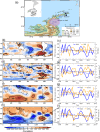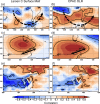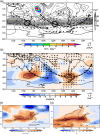Central tropical Pacific convection drives extreme high temperatures and surface melt on the Larsen C Ice Shelf, Antarctic Peninsula
- PMID: 35831281
- PMCID: PMC9279480
- DOI: 10.1038/s41467-022-31119-4
Central tropical Pacific convection drives extreme high temperatures and surface melt on the Larsen C Ice Shelf, Antarctic Peninsula
Abstract
Northern sections of the Larsen Ice Shelf, eastern Antarctic Peninsula (AP) have experienced dramatic break-up and collapse since the early 1990s due to strong summertime surface melt, linked to strengthened circumpolar westerly winds. Here we show that extreme summertime surface melt and record-high temperature events over the eastern AP and Larsen C Ice Shelf are triggered by deep convection in the central tropical Pacific (CPAC), which produces an elongated cyclonic anomaly across the South Pacific coupled with a strong high pressure anomaly over Drake Passage. Together these atmospheric circulation anomalies transport very warm and moist air to the southwest AP, often in the form of "atmospheric rivers", producing strong foehn warming and surface melt on the eastern AP and Larsen C Ice Shelf. Therefore, variability in CPAC convection, in addition to the circumpolar westerlies, is a key driver of AP surface mass balance and the occurrence of extreme high temperatures.
© 2022. The Author(s).
Conflict of interest statement
The authors declare no competing interests.
Figures






References
-
- Vaughan DG, Doake CSM. Recent atmospheric warming and retreat of ice shelves on the Antarctic Peninsula. Nature. 1996;379:328–331. doi: 10.1038/379328a0. - DOI
-
- Scambos, T., Hulbe, C. & Fahnestock, M. in Antarctic Research Series (eds Domack, E. et al.) (American Geophysical Union, 2003).
-
- Ingels, J. et al. Antarctic ecosystem responses following ice‐shelf collapse and iceberg calving: Science review and future research. WIREs Clim. Change12, e682 (2021).
-
- Rott H, Skvarca P, Nagler T. Rapid collapse of Northern Larsen ice shelf, Antarctica. Science. 1996;271:788–792. doi: 10.1126/science.271.5250.788. - DOI
Publication types
MeSH terms
LinkOut - more resources
Full Text Sources

